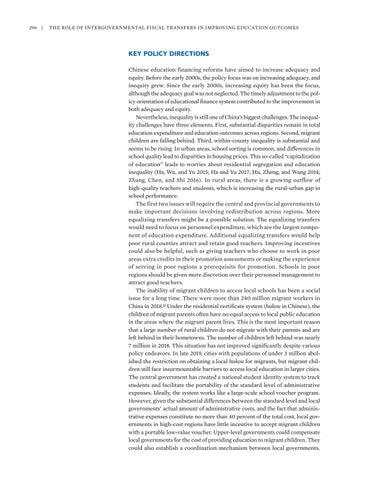296 | The Role of Intergovernmental Fiscal Transfers in Improving Education Outcomes
KEY POLICY DIRECTIONS Chinese education financing reforms have aimed to increase adequacy and equity. Before the early 2000s, the policy focus was on increasing adequacy, and inequity grew. Since the early 2000s, increasing equity has been the focus, although the adequacy goal was not neglected. The timely adjustment to the policy orientation of educational finance system contributed to the improvement in both adequacy and equity. Nevertheless, inequality is still one of China’s biggest challenges. The inequality challenges have three elements. First, substantial disparities remain in total education expenditure and education outcomes across regions. Second, migrant children are falling behind. Third, within-county inequality is substantial and seems to be rising. In urban areas, school sorting is common, and differences in school quality lead to disparities in housing prices. This so-called “capitalization of education” leads to worries about residential segregation and education inequality (Ha, Wu, and Yu 2015; Ha and Yu 2017; Hu, Zheng, and Wang 2014; Zhang, Chen, and Shi 2016). In rural areas, there is a growing outflow of high-quality teachers and students, which is increasing the rural-urban gap in school performance. The first two issues will require the central and provincial governments to make important decisions involving redistribution across regions. More equalizing transfers might be a possible solution. The equalizing transfers would need to focus on personnel expenditure, which are the largest component of education expenditure. Additional equalizing transfers would help poor rural counties attract and retain good teachers. Improving incentives could also be helpful, such as giving teachers who choose to work in poor areas extra credits in their promotion assessments or making the experience of serving in poor regions a prerequisite for promotion. Schools in poor regions should be given more discretion over their personnel management to attract good teachers. The inability of migrant children to access local schools has been a social issue for a long time. There were more than 240 million migrant workers in China in 2018.11 Under the residential certificate system (hukou in Chinese), the children of migrant parents often have no equal access to local public education in the areas where the migrant parent lives. This is the most important reason that a large number of rural children do not migrate with their parents and are left behind in their hometowns. The number of children left behind was nearly 7 million in 2018. This situation has not improved significantly despite various policy endeavors. In late 2019, cities with populations of under 3 million abolished the restriction on obtaining a local hukou for migrants, but migrant children still face insurmountable barriers to access local education in larger cities. The central government has created a national student identity system to track students and facilitate the portability of the standard level of administrative expenses. Ideally, the system works like a large-scale school voucher program. However, given the substantial differences between the standard level and local governments’ actual amount of administrative costs, and the fact that administrative expenses constitute no more than 40 percent of the total cost, local governments in high-cost regions have little incentive to accept migrant children with a portable low-value voucher. Upper-level governments could compensate local governments for the cost of providing education to migrant children. They could also establish a coordination mechanism between local governments.






